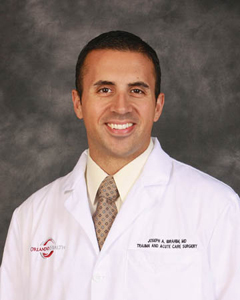Should I go to the ER or Urgent Care?
Whether it’s sudden chest pain or a high fever, it can be difficult to know when to go to an emergency room for treatment.
All too often, people abide by the idea of “better safe than sorry” — which is understandable — but sometimes certain conditions or injuries can be handled outside of the emergency room. According to a National Center for Health Statistics study, 48 percent of people went to the ER only because their doctor’s office wasn’t open.
That’s not what ERs are for. If you can’t get to your regular doctor right away, an urgent care center is another option for evaluation and treatment.
The Difference Between an ER and Urgent Care
ERs are designed to handle life-threatening illnesses, conditions or injuries.
If you have trouble breathing, chest pain, a sudden, mind-numbing headache, weakness or numbness on one side of the body, heavy bleeding, a deep wound or a serious burn injury, it’s best to go to the emergency room for treatment. A variety of other symptoms also can lead to an ER visit, including seizures, a severe allergic reaction that obstructs your airway, a drug or alcohol overdose and a high fever that doesn’t get better with medication or one that is accompanied by a stiff neck or headache. The bottom line is that if you feel your life is at risk or if you’ve experienced a serious trauma like a car accident or fall that may lead to permanent disability, go to the ER immediately.
There are about 7,100 urgent care centers across the country, most of which see dozens of patients every day. Similar to an ER, these centers are staffed with trained doctors, nurses and other medical professionals. A majority of urgent care centers have multiple experienced clinicians including MD’s, NP’s and PA’s, so an urgent care center will still be able to provide you the care you need.
The main difference between an ER and an urgent care center is the type of conditions and injuries each facility treats. An urgent care center is designed to handle non-life threatening emergencies. If you have a sore throat, a cold, the flu, a minor sprain, cut or burn, an urgent care center is the best place to seek care if you can’t see your regular doctor within 24 hours.
These centers also have another advantage: cost and wait times. The emergency room has a standard protocol for evaluating the urgency of each patient's condition and allocating resources accordingly. It will strive to treat every guest as soon as possible, but sometimes, when there are a multitude of patients in the emergency room, wait times can be longer than usual. In addition, most urgent care centers have transfer agreements or work closely with hospitals. This means that if someone requires a higher level of care, they can facilitate the transfer in an urgent fashion which will also help avoid the wait in the ER if they are more severely ill.
According to one analysis by the American College of Emergency Physicians (ACEP), the average ER wait time is 4.5 hours and the average cost of a visit is $1,757. That’s compared to an average cost of $155 for an urgent care visit and an average wait time of 30 minutes at 90 percent of urgent care centers, according to the Urgent Care Association of America.
For true emergencies, it’s best to call 911 so an ambulance can transport you to the hospital. If you have any other of the serious symptoms I’ve mentioned, the ER is the best place to seek care. Urgent care centers are a great option if you have an “urgent” condition, meaning one that requires care within 24 hours but isn’t life threatening. However, these centers aren’t a substitute for regular doctor’s visits and shouldn’t be used for primary care. Instead, they can bridge the care gap when your condition or injury requires care outside of regular office hours or if your primary care physician is away or unavailable to treat you. Even if you go to an urgent care center, it doesn’t hurt to schedule a follow-up visit with your doctor. That way you know you’re getting the best and most comprehensive care possible.
Discover more about Orlando Health's partnership with CareSpot Urgent Care
For patients, the new partnership provides the ability to seamlessly connect to a broad spectrum of health care – from urgent to acute – within their own communities, close to home. The partnership, which became effective September 1, 2017, includes eight existing centers located in or on Altamonte Springs, Apopka, East Sand Lake Road, Kissimmee, Lake Mary, Metro West, South Orange Avenue and Winter Springs, as well as all future centers. The centers are being co-branded CareSpot Urgent Care | Orlando Health.
Learn More Here


